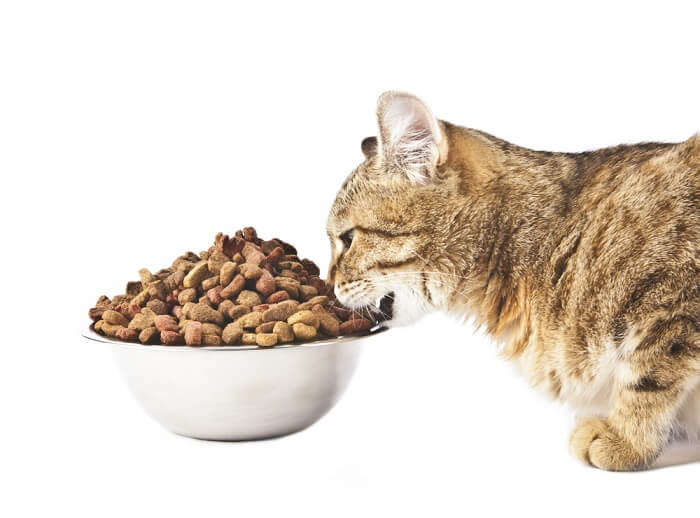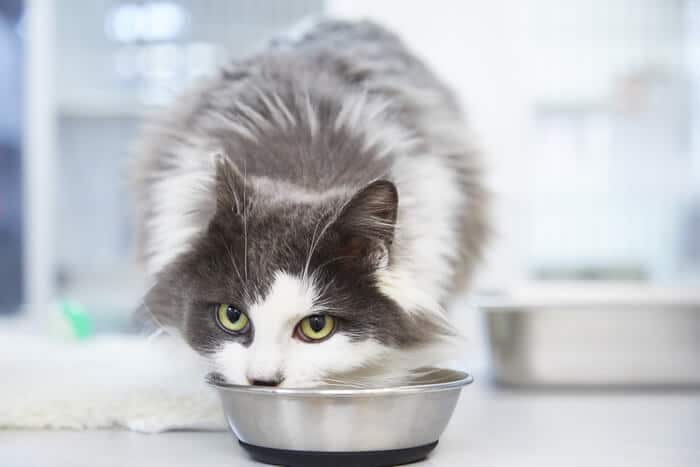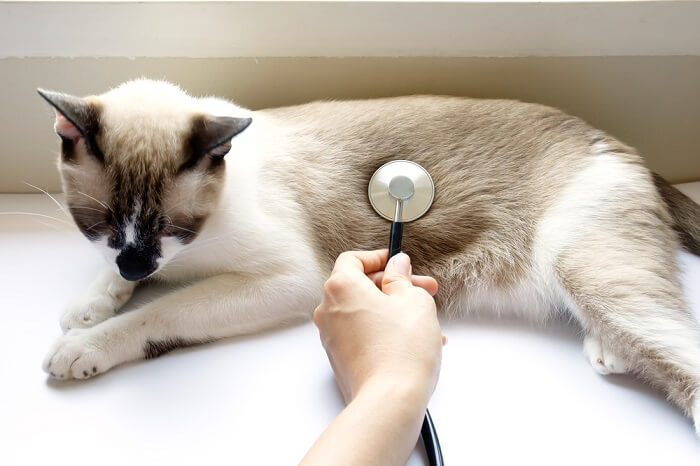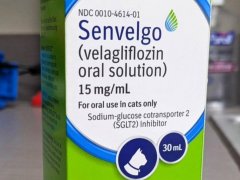
FortifFlora Feline Probiotic Supplement is a probiotic supplement made by Nestle Purina as part of their Pro Plan Veterinary Supplements line of products.
In this article you’ll learn what FortifFlora is, how it works as a probiotic, evidence to support its use, and some frequently asked questions.
Fortiflora Probiotic for Cats Overview

About Fortiflora for Cats

Purina Pro Plan Veterinary Supplements FortifFlora is a probiotic supplement indicated to help promote better stool quality and digestive health and balance.
The intestinal tract is an environment that supports many strains of different types of bacterial microflora that all need to be maintained within a certain balance to help with proper digestion and avoid digestive upset.
If there is a shift in the bacterial balance within the digestive tract, this can lead to overgrowth of some bacteria that may contribute to what is called dysbiosis, where we can see digestive issues like loose stool and diarrhea develop.
What a probiotic seeks to do is to help restore and maintain that balance for intestinal health by providing one or more strains of beneficial commensal bacteria to counteract the growth of other bacteria that may be more harmful if allowed to overpopulate within the gut.
Also Read: 11 Best Probiotics For Cats
The bacterial strain that FortifFlora contains is called Enterococcus faecium.
Fortiflora comes in a box containing 30 packets of flavored powder that is typically mixed with canned or soft food once daily.
As a supplement, FortifFlora can be purchased over the counter without a prescription. Although a prescription is not needed, it’s still best to use this product under direction of your veterinarian for the best results.
FortiFlora SA Synbiotic Action is a variation on the original FortifFlora product. FortifFlora SA contains psyllium fiber, which acts as a prebiotic to promote the growth of other specific commensal bacteria like Lactobacillus and Bifidobacterium species.
What Does Fortiflora Do for Cats?

The bacterial strain that FortifFlora contains, Enterococcus faecium, is a strain of bacteria naturally found within the digestive tract.
Enterococcus bacteria have some specific characteristics that can make them a useful bacterial type to include in a probiotic.
A 2018 article in Frontiers of Microbiology entitled “The Genus Enterococcus: Between Probiotic Potential and Safety Concerns—An Update” describes some of these characteristics.
Enterococcus bacteria are highly competitive and resistant to changes in temperature and pH. This means they can more easily survive environmental changes traveling in a probiotic powder form through the stomach and into the intestinal tract.
The manufacturer also indicates that FortiFlora is manufactured using a proprietary microencapsulation process for enhanced stability to aid in passage through the GI tract.
Enterococcus bacteria produce compounds called bacteriocins, which have the ability to target certain other bacterial strains, especially pathogenic (disease-causing) bacteria like Salmonella, Listeria, and Clostridium species.
The combination of outcompeting undesirable bacteria as well as being able to target and inhibit them is what gives FortiFlora some of its distinctive advantage as there are only a couple of veterinary supplements approved to include Enterococcus faecium.
Some folks may wonder how a powdered supplement kept at room temperature could possibly contain live microorganisms.
A really great article from 2020 that answers this question is blog article posted on the website for the International Scientific Association for Probiotics and Prebiotics (ISAPP) written by Gabriel Vinderola, PhD, an associate professor in microbiology at the National University of Litoral in Argentina.
In the article, Professor Vinderola describes that most probiotic products appear as a white powder due to the process of freeze-drying or lyophilization. By quickly removing water from around and inside the bacterial cells, the microbes are not killed, but enter a dormant state where their metabolic activity is put on hold.
When these dormant little bacteria enter the gut, the environmental conditions trigger a restart in the metabolic processes of the bacteria, allowing them to grow, reproduce, and generally be active to provide their health benefits.
It’s true that some amount of cell death may still occur during a product’s shelf life, but this is one reason why such high levels of colony forming units (CFUs) are found in probiotics. FortiFlora contains 100 million colony forming units of Entercoccus faecium, which is a moderate amount. Some probiotics may contain billions of CFUs in different combinations.
There is research evidence that does support FortiFlora’s use in cats as a way of supporting kitties experiencing diarrhea from presumed bacterial imbalance.
Back in 2011, a study published in the Journal of Veterinary Internal Medicine entitled “Effect of the Probiotic Enterococcus faecium SF68 on Presence of Diarrhea in Cats and Dogs Housed in an Animal Shelter,” found that when given to just over 200 cats, the percentage of cats with diarrhea given FortiFlora was considerably lower when compared to a placebo group.
More recently in 2017, a study published in Topics in Companion Animal Medicine entitled “Effect of Enterococcus faecium Strain SF68 on Gastrointestinal Signs and Fecal Microbiome in Cats Administered Amoxicillin-Clavulanate,” found that in cats given the common antibiotic amoxicillin-clavulanate for seven days, cats given FortiFlora for 14 days had better fecal scores compared to cats given a placebo for the same period of time.
Side Effects of Fortiflora for Cats

Talk to your veterinarian before starting any new supplement, including probiotic supplements like FortiFlora.
According to the manufacturer, FortiFlora for cats is not known to have any observed or expected side effects. And generally, many veterinarians would agree that probiotics appear to be safe and well-tolerated by a majority of pets.
Some folks may recognize Enterococcus as a bacteria that has the potential to cause disease, sometimes cultured from some infections.
The authors of “The Genus Enterococcus: Between Probiotic Potential and Safety Concerns—An Update” discuss this as part of the risk/benefit assessment for using Entercoccus as a probiotic.
While Entercoccus faecium may occasionally be found contributing to infections in human patients, this is predominantly in hospitalized patients. While these infections can be very serious, they are considered very rare outside of a hospital environment where patients are already ill and have very compromised immune systems.
In the same vein, the manufacturer of FortiFlora does recommend exercising caution using FortiFlora in pets with severely compromised immune systems. It’s important to discuss FortiFlora use with your vet if you have concerns that your cat may have a severely compromised immune system.
Enterococcus faecium is a bacterial strain normally found in the digestive tract, and so in cases in veterinary medicine where it may be cultured out of a wound for example, it’s very likely these bacteria were introduced through fecal contamination or when a kitty (being the fastidious bottom groomers that they are) try to lick/clean a wound and end up contaminating it.
It’s important to remember that in the powdered form you’re adding to your cat’s food, the bacteria contained are in a dormant state and do not become “active” until they reach the gut. Handling probiotic powder therefore, is not considered to be a significant contamination risk.
Fortiflora for Cats Dosage
The box of FortiFlora comes with 30 1-gram packets. Each gram contains 100 million CFUs of Entercoccus faecium.
Per the manufacturer, the dose of FortiFlora is one packet fed once a day.
When or whether your cat should be on a probiotic, and how long your kitty should stay on a product like FortiFlora, should be discussed with your veterinarian.
Probiotics may be recommended for only a short period if a cat has a short, mild case of soft stool or diarrhea, or diarrhea associated with antibiotic use.
Also Read: Vet Approved Cat Stool Chart: Decoding Your Cat’s Poop
However, there may be other health conditions where a probiotic may be recommended for long-term use. Whether FortiFlora is used for a short-term or long-term period depends on your vet’s assessment of your cat’s condition and discussions you’ve had.
The FortiFlora powder packet is most commonly added to canned or wet food. FortiFlora has flavoring in the form of animal digest (a hydrolyzed pork/poultry ingredient now called “liver flavor”), so many cats may find it tasty.
However, as we all know, cats can be picky about what they eat. It is possible to mix FortiFlora with water. However, it may be more effective to mix it with a small volume of water in a syringe and administer it directly and carefully to your kitty that way to get the most benefit out of it.
Adding FortiFlora to a water bowl that your cat may come back to drink from a couple times a day is very unlikely to provide the same benefit. Because it is intended to be given every 24 hours, the full amount of the packet should be consumed within that period of time.
The bacterial strain found in FortiFlora is a normal commensal organism of the digestive tract and is believed to carry far more benefits than risks in supplementation. While it is not a prescription item, you should still consult with your veterinarian about when to use FortiFlora and how long it should be used for.
Drug Dosing Disclaimer: We are only able to provide doses for medications that are FDA approved for use in cats and only as the label guidelines dictate. For medications that are used off-label we can only provide guidelines and safety information for use. Safe and appropriate dosing for off-label medications can only be determined by a primary care veterinarian.
We encourage you to work with your veterinarian to determine if a particular medication is appropriate for your cat. Changing or adjusting a dose for your cat on your own without consulting with a veterinarian can carry risk. We do not encourage use of medications prescribed for human use in pets without first consulting with a primary care veterinarian.
Frequently Asked Questions
What does FortiFlora do for cats?
FortiFlora probiotic for cats is a powdered feline nutritional supplement intended to help support the health and balance of the digestive tract. In this way, it may help cats experiencing loose stools, diarrhea, or other digestive issues secondary to an imbalance of the bacterial balance or microbiome of the gut.
What are the side effects of FortiFlora for cats?
Side effects are uncommon when using a probiotic supplement. According to the manufacturer of FortiFlora, side effects are not observed or expected when using FortiFlora. Because probiotics contain live cultures of particular bacteria, they should be used cautiously in any pets with severe immune system compromise.
Is FortiFlora bad for cats?
No, FortiFlora is not bad for cats. The commensal bacteria strain found in FortiFlora, Entercoccus faecium, is already normally found in the digestive tract. As a probiotic, it has the ability to outcompete and inhibit other bacteria more likely to cause disease like Salmonella, Listeria, and Clostridium species.
While Enterococcus bacteria can cause infections, this is typically only in hospitalized or severely immunocompromised patients where fecal contamination, such as of a wound, may have occurred. Use of probiotics is not known to be connected to such uncommon occurrences.
It is important to remember that any pet could have an unexpected sensitivity to something new. If you feel you are noticing new concerns in your cat after starting Fortiflora, make sure to touch base with your veterinarian.
How long should a cat take FortiFlora?
This depends greatly on FortiFlora’s intended use. Short courses to help clear up mild cases of diarrhea or while a kitty is taking an antibiotic may only last for a couple weeks. Some chronic health conditions may see benefit from long-term use of a probiotic, requiring use for months, years, or life-long.
When using FortiFlora, it is very important to discuss with your veterinarian how long your kitty should be using FortiFlora for.








My 15 year old cat was given probiotic along with an antibiotic for a stomach upset.
She is fine now but liked the probiotic so much I have continued with it approx I sachet per day. I have noticed increased use of litter tray. Does it have a a diuretic effect.
Hi Edward,
At least for fortiflora, there is no diuretic effect I am aware of or have heard of before. The same goes for proviable, which I have prescribed a lot and used for my cats. There is no mechanism there that would make sense to me. I couldn’t say for probiotic combination products that are combined with other supplement ingredients. In combination products it’s possible some supplement ingredient is having that effect, though I couldn’t say what it would be.
my 11 years old cat started to cough and sometime sneezed after I started to given her FORTIFLORA PROBIOTICS, could she be allergic to them?
Hi Beatriz,
I would think a true allergy of that nature to be highly unlikely. However, since it is a fair amount of powder per packet, it might be possible for a cat to inhale it when getting into the bowl to eat it, if the powder is sprinkled on top. This could cause some signs like coughing or sneezing. Mixing it thoroughly with soft food may help to avoid that from happening. Otherwise, I would consider the coughing and sneezing to have a different underlying cause to be looked into.
Okay, so if it was you, you’d keep giving her the Fortiflora?
I would only think the probiotic would generally help and that some other underlying reason is contributing more to the constipation.
Thanks for your quick reply! So regarding the Fortiflora, should I just keep giving her the same amount that I have been? My mother won’t let me take her to the vet. (I’m 45 but she’s very controlling.) Is there anything around the house that I can give her that might help? Thanks!
Since Fortiflora really just has one dosage, you may not get the full benefits of the probiotic by reducing the amount. An 1/8 to 1/4 teaspoon of Miralax once to twice a day could be considered to help relieve signs of mild constipation. But as I said, addressing it symptomatically instead of investigating a root cause may have its limitations for how effective that is or how long it may work for.
My cat started pooping in the living room intermittently last autumn, which was normal stool and then what I call a ‘secondary splat’ of diarrhea nearby, which lasted through the winter. I started buying FortiFlora and it dramatically lessened, going from her doing it 10 times in December, to 8 in January, and then twice in February. It’s been usually once per month since then, but the past week and a half she unexpectedly did it 3 times. (With no ‘secondary splats’.) Also, since the first recent time, she suddenly doesn’t poop for 48-60 hours, when she was going usually every 36 hours before that. (As I type this, she hasn’t pooped for 42 hours.) I’ve been giving her approx half a packet of Fortiflora every day, sprinkling some in her wet food feedings throughout the day. Could it be constipating her now? She I stop giving it to her? If so, do I gradually decrease it, or stop it cold-turkey? I don’t know if she’ll eat her wet food without it because she loves it. What should I do? (Oddly, a few weeks ago, she had diarrhea a couple of times, which she did in the litterbox, thank God.) She is 16 1/2 years old, but has incredible energy, still running, playing soccer with her toys, jumping on high things, flying up and down the stairs…it’s amazing. She has lost weight in the past year, but not too much. To look at her, you’d probably think she’s under 10 years old except that she recently developed that elderly muscle loss in her hind end, but she still weighs at least 12 pounds. Any opinion you have will help me immensely! Thanks!
Hi Deana,
I haven’t appreciated that Fortiflora or other solely probiotic supplements contribute to constipation. There is likely to be some underlying cause for your kitty’s stool issues. Sometimes probiotics can help, but they are not considered a sole treatment.
Something may have now changed with your cat’s body that is contributing to firmer stools that are harder to pass. If you have continued to see some stool quality concerns and there has been more noticeable weight loss over the last few months, it would be a good idea to work with your vet to have her examined and get some health screen testing done. Although she is older and still enjoys life, that is often the best time to screen for health concerns so that they can be addressed early.
My cat had similar problems..his diagnosis is exocrine pancreatic insufficiency (epi) I have to put pancreatic enzymes in all his food..it is trial &error..and a full time job..he is older and seems to have lost his sense of smell.
Fortliflora is great..he loves it..I manage 1 pakerbper day..sprinkling a little to tantalize him.
Is there a way to purchase a powder that just has the liver flavor so I could use it for all meals? We have a cat with CKD who has been refusing to eat almost everything, until I stir in some FortiFlora and a little water. He still doesn’t eat all the food, but a good portion of it. He LOVES this stuff.
Hi Judi, not that I’ve heard. You could check with your vet to get their opinion too, but if it helps a lot with enytcing his appetite, it would probably be okay to split the packet of powder as equally as possible with meals, as long as he’s still getting the whole packet per day. Especially if we’re just talking about 2-3 meals. You could also get your vet’s opinion on using more than one packet per day. If adding the Fortiflora appears to help his interest, by adding more Fortiflora with each meal, you might find that in the end you’re only adding the amount of one full packet total, especially if your cat doesn’t finish his whole meals. Probiotics are generally very safe to use, so there can be some wiggle room if you’re seeing some good benefits and no concerns from their use.
Thank you for this great review ! Our cat suffers from constipation ( for many years now ) and I am a bit desperate to help her.
Could Probiotics be helpful ? This specific one or any other you recommend ?
The vet , has put her on Miralax and advised it is safe for long term daily intake , but I am a bit worried.
Thank you sssooooo much in advance,
Dana
Hi Dana, thanks for your kind comment. While probiotics are not going to hurt, they are not designed specifically to help with constipation, which is not typically related directly to bacterial imabalance. Miralax is a commonly used long-term product to help alleviate constipation in cats, and it’s very safe to use as long as you keep an eye on stools and adjust the dose amount as needed. Miralax is an osmotic diuretic, so it works simply by getting water in the body to go where it needs to. When constipation is present, it helps to draw water into the colon to moisten the stool and allow it to pass more easily. There are also prescription diets you could talk to your vet about that are designed with the right proportions of extra fiber to help with constipation.
Thank you sooooo much ! I will sleep better knowing
that the Miralax is safe for long term use . And thank you
all these incredibly helpful articles, amazing work ! Will maybe keep the probiotics on standby then and see how it goes . Thank you again !!!
We have three cats. One has taken to leaving a number of droppings of poop daily on the basement floor where the box is located. We added a second box in case that was the issue. The box gets used but the droppings still continue. At least these stay in the basement. Is this a problem that FortiFlora might be able to help? And, because the cats share the three bowls, would it a problem if the other two also got doses of FortiFlora?, too. We’d really appreciate your thoughts.
It depends on the underlying cause of the poop droppings (probably constipation, but you may want to talk with a vet to confirm). FortiFlora can help to regulate the digestive process and alleviate constipation, and it’s perfectly fine to give it to all of your cats, whether or not they’re exhibiting the same issues.